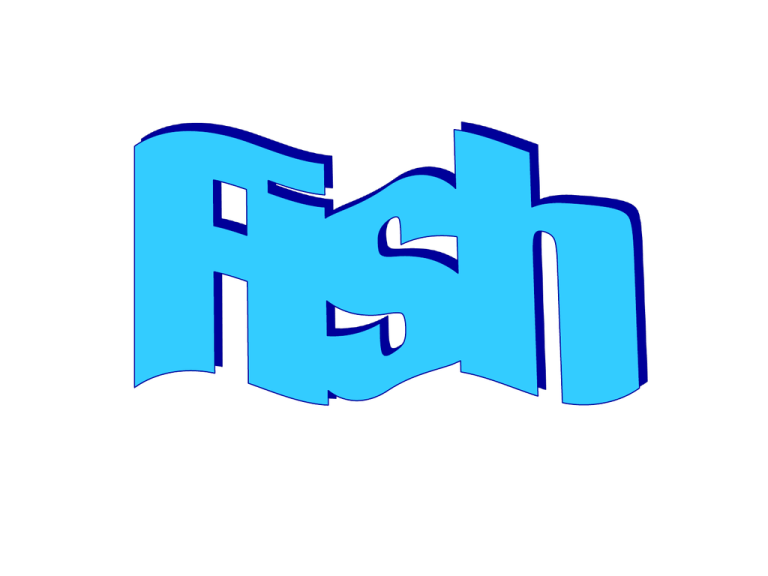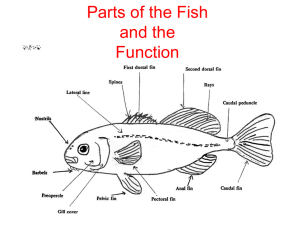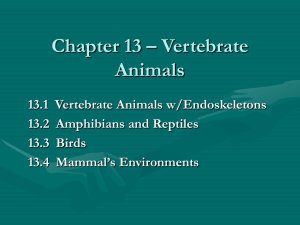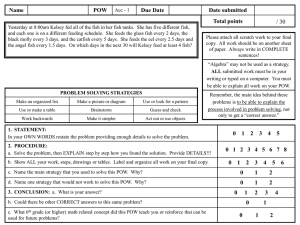
Date back 425-500 million years ago. Early fish were called
Ostracoderms and were slow, bottom-dwelling animals
covered with thick, bony plates and scales. Believed to be the
first animal with a backbone.
Two (2) groups evolved from the Ostracoderms that exist
today:
Chondrichthyes: fish with cartilage skeletons (sharks, rays,
skates, etc.)
Osteichthyes: fish with bony skeletons. Two (2) subclasses:
Sarcopterygii: fish with fleshy or lobed fins, skeletons
part cartilage and part bone. Two (2) orders:
Dipteriformes (lung fish) & Coelacanthiformes
Actinopterygii: 34 orders of more than 20,000 species
Cold-blooded vertebrates that breathe with gills and move with fins.
Most numerous of all vertebrates with over 30,000 species.
Smallest ~ Philippine island goby, Pandaka pygmaea, 1/3 – ½” long
Largest ~ whale shark, Rhincodon typus, about 50’ & weighs several
tons!
Most fish are covered with scales ~ thin, bony plates that overlap each
other and provide protection.
Scales of fish are of 4 types:
Ctneiod: serrations on edges & rough surfaces; feel rough to touch
Cycloid: smooth surfaces & edges; make fish feel smooth & slick
Gamoid: very thick & heavy; similar to scales on ancient species of
fish. Found on gar & birches.
Placoid: scales on sharks & rays that are pointed and similar to
teeth
Skin of the fish contains glands that produce a slimy mucus,
which makes it slippery and provides protection from bacteria. Skin
contains chromatophores, pigment cells that give fish their color.
Fins are movable structures that aid the fish in swimming &
maintaining balance.
Most fish have at least one (1) vertical dorsal fin along their back,
a single anal fin on underside near tail, and a caudal fin (tail). Some
have an adipose fin~small, fleshy fin located on back between
dorsal and caudal fin. One set of identical paired fins, which is
found on side, just behind the head, called pectoral fins. One set
called pelvic fins found below and just behind pectoral fins.
Fish breathe through gills. Water is drawn in through the mouth,
forced back into pharynx, and out through gills.The DO (dissolved
oxygen) in water is taken into the blood, and CO2 is released into
the water because of different concentrations of gasses between
water and blood.
•Swim bladder: located in abdominal cavity; filled with gasses produced
by blood, which enables fish to maintain a particular depth.
•A fish’s heart is a long, folded organ consisting of only two (2)
chambers: atrium (auricle) and ventricle. The blood makes a simple,
single circuit in the fish’s circulation system.
•Most fish are able to react to changes in the water pressure, temperature,
currents, and sounds because of a lateral line that runs along their side
from behind the gill cover to the base of the tail. A series of pressuresensitive cells called neuromasts are contained in tubes along lateral line.
Pores opening into the tubes bring the cells into contact with the water.
•Fish’s eye has a spherical lens that focuses by moving within the
eyeball, not by changing curvature of lens.Fish don’t have eyelids; eye
kept moist by flow of water. Size of eye usually depends on amount of
light reaching the eye. (Brighter the light, the smaller the eye.)
•All fish have inner ears.
•Fish have taste buds in their mouth, on their lips, and on the body
and fins. Sense of smell is highly developed. Some have taste buds
on barbels, whisker-like projections around the mouth.
•Where fish occupy tank space (top, middle, bottom) is usually an
indication of the type of diet and feeding habits. Structure of their
mouth also indicates what level they occupy.
•Top level fish feed on insects that fall into the water. Mouths
are usually turned upward to enable them to feed easier. Most
have long, streamlined bodies and can propel themselves
rapidly through water to catch prey.
•Middle level fish are active swimmers with streamlined
bodies. Usually have small mouths which are straight forward.
•Bottom dwellers live on the bottom of streams, rivers, and
lakes. Mouths are usually downward, which enable them to
pick up food from bottom. Equipped with barbels to assist them
in feeling their way along the bottom to find food.
Predator fish have teeth on front of jaws, roof of mouth, and throat
teeth just in front of esophagus to usually consume prey whole.
Sharks and piranha have cutting teeth for biting pieces from their
prey.
Some fish have rasp-like teeth to scrape plant and animal growth
from rocks. Some species only have teeth in the pharynx to grind
food before it enters esophagus.
Food enters esophagus – stomach – intestine – anus
Lung fish, shark, and rays have a cloaca through which waste
material passes.
**Fish should be fed 2-3 times a day and receive only what they can
consume in 3-5 minutes.**
Kingdom: Animalia
Phylum: Chordata
Superclass: Pisces (all fish)
Class: Agnatha or Cyclostomata (jawless fish, have sucking or filterfeeding mouths)
Class: Chondrichthyes – fish with cartilaginous skeletons
Class: Osteichthyes – fish with bony skeletons
Subclass: Actinopterygii (ray-finned fish) – 34 orders
Determining the number of fish that can be put into a tank, you
must first multiply the length x width to determine the square inches
of surface area.
Tropical freshwater fish: no more than 1” of fish for every
10 sq. ins.
Cold freshwater fish: 1” of fish for every 30 sq. ins.
Marine fish: 1” for every 48 sq. ins.
•The aquarium should be in a draft free area and out of direct sunlight.
•Aquariums use filters and air pumps to keep the water clean and
contain adequate amounts of dissolved oxygen.
•The purpose of a filter in an aquarium is to remove solid waste and
uneaten food materials from the water.
•Aeration is done by the use of electrically driven air pumps.
•Several factors contribute to an increase in ammonia and nitrate in a
tank:
•Increase in waste material & uneaten food
•Dirty filters
•Failure to change water at regular intervals (1/4 to 1/5 every 3-4
weeks)
•Overfeeding
•Overpopulation
Fish reproduce by the fertilization of the female’s eggs by the
sperm (milt) of the male. This process is called spawning in fish.
Types of Reproduction
Egg-Scatterers:Fish that lay eggs in a haphazard manner of floor of
an aquarium. No parental care of eggs or young; must be careful so
that parents don’t eat the fry (newly hatched eggs). Exs: Barbs,
Danios, Goldfish
Egg buryers: Fish that lay their eggs in the mud of rivers and ponds
that dry up. Adults die when water dries up. The eggs survive in the
mud, and when the next rain comes, the young hatch. Ex: killifish
Egg depositers: Excellent parents. Select their own mates. Clean off a
nesting site where the female deposits the eggs and the male fertilizes
them. The parents usually take turns guarding the nest. They constantly
fan the nest and eggs to keep dirt and dust from settling on them. After
the young hatch, the parents keep watch over them for several days to
protect them from enemies. Exs: Cichlids, Catfish, Sunfish
Mouth brooders: Fish that carry their eggs in their mouth until they
hatch, after which they may continue to be carried there until they can
fend for themselves. After the eggs are deposited and fertilized, the
female (usually) goes around and picks up the eggs by mouth. During
this period of 2-3 weeks, the parent doesn’t eat. Ex: Betta
Nest builders: Construct a nest in which eggs are deposited.
Usually made by the male. After eggs are fertilized, the female
should be removed because the male will become aggressive. The
male guards the nest until fish hatch. Ex: Gouramis
Live Bearers: Give birth to 20-200 young fry. Females store the
milt in their oviducts for several months, thus several broods can
be produced from one mating. Exs: Guppies, Swordtails, Mollies
Some signs that may indicate a disease problem include:
Unusual behavior, leaning to the side, fins not extended,
caudal fin closed or rolled, slow movement, respiration
faster than normal, on surface gasping for air, fish
rubbing against decorations, fish not eating, fish thin
with sunken sides, abnormally large or swollen bellies,
abnormal color, frayed fins, malformation of back,
cloudiness of the eyes, and scales sticking out away from
the body.
Infectious: Caused by pathogenic organisms present in
the environment or carried by other fish. They are
contagious. Include parasites, bacteria, viruses, and fungi.
Noninfectious: Not contagious. Caused by environmental
problems, nutritional deficiencies, or genetic defects.
Usually cannot be cured by medications.
Choose 2 infectious and 2 noninfectious diseases. Write down their
names, symptoms, causes, treatments, & prevention for each.
1.) What are the 2 groups that evolved from Ostracoderrms?
2.) Name & describe 4 types of fish scales.
3.) Define chromatophores.
4.) What’s the purpose of of a swim bladder?
5.) What is a lateral line?
6.) How do fish mouth structures differ?
7.) Name the complete scientific classification for one freshwater
and one saltwater fish.
8.) List 3 factors that increase ammonia and nitrate levels.
9.) Name & describe 4 ways fish reproduce.
10.) List 6 signs that may indicate a disease problem.










